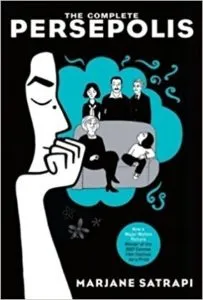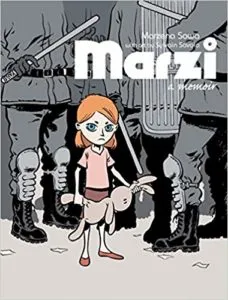
Graphic Biographies and Comics Journalism for the History Nerds
This content contains affiliate links. When you buy through these links, we may earn an affiliate commission.
This is a guest post from Julia Rittenberg. Julia is a professional nerd who can be spotted in the wild lounging with books in the park in Brooklyn, NY. She has a BA in International Studies from the University of Chicago and an MA in Media Studies from Pratt Institute. Her graduate work focused on theatrical adaptations of literary works with big fandoms. Her favorite activity is listening to fans about what they love. Tell her about your fandoms on Instagram @juliaobservateur and Tumblr.
 My favorite memoir of all time is Persepolis by Marjane Satrapi. I even got to teach it in an English class. Although for some students it was difficult to engage with the crash course in ancient Persian and recent Iranian history, Satrapi’s deft juxtapositions of her childhood and the conflict drew me in more than I originally expected. It was an especially exciting read for students who spoke English as a second language. Being able to focus on the panels made the reading experience more pleasurable.
In fact, history and current events journalism through comics are continuing to gain popularity. The use of comics and drawing to display these events is no less “truthful” or objective than photojournalism and simple articles. The histories seem more intimate, and the comics give an immediacy to the events as they unfold. Here are a few suggestions to get started on your history nerd deep-dives.
My favorite memoir of all time is Persepolis by Marjane Satrapi. I even got to teach it in an English class. Although for some students it was difficult to engage with the crash course in ancient Persian and recent Iranian history, Satrapi’s deft juxtapositions of her childhood and the conflict drew me in more than I originally expected. It was an especially exciting read for students who spoke English as a second language. Being able to focus on the panels made the reading experience more pleasurable.
In fact, history and current events journalism through comics are continuing to gain popularity. The use of comics and drawing to display these events is no less “truthful” or objective than photojournalism and simple articles. The histories seem more intimate, and the comics give an immediacy to the events as they unfold. Here are a few suggestions to get started on your history nerd deep-dives.
Marie Curie and her husband Pierre fell in love in a cloud of radioactivity, as Redniss takes us through dreamlike drawings of Marie and Pierre darting through their laboratory. The intense, scientific calculations and information come across as romantic in the context of Marie and Pierre’s true love for the work they were doing. Of course, the catch is that we know how radioactivity can affect a body, especially the body of a woman who devoted her life to it.
The personal and political are intertwined beautifully throughout Marzena’s memoir of girlhood in communist Poland. Government corruption, unstable leaders, and the need to question the society around us are all as relevant as ever. Savoia’s illustration evokes the raw sensitivity of Marzi’s childhood with Marzi’s big eyes and colorful attire, while she is often surrounded by a gray, uncompromising world. A necessary read for making it through tumultuous times.
 My favorite memoir of all time is Persepolis by Marjane Satrapi. I even got to teach it in an English class. Although for some students it was difficult to engage with the crash course in ancient Persian and recent Iranian history, Satrapi’s deft juxtapositions of her childhood and the conflict drew me in more than I originally expected. It was an especially exciting read for students who spoke English as a second language. Being able to focus on the panels made the reading experience more pleasurable.
In fact, history and current events journalism through comics are continuing to gain popularity. The use of comics and drawing to display these events is no less “truthful” or objective than photojournalism and simple articles. The histories seem more intimate, and the comics give an immediacy to the events as they unfold. Here are a few suggestions to get started on your history nerd deep-dives.
My favorite memoir of all time is Persepolis by Marjane Satrapi. I even got to teach it in an English class. Although for some students it was difficult to engage with the crash course in ancient Persian and recent Iranian history, Satrapi’s deft juxtapositions of her childhood and the conflict drew me in more than I originally expected. It was an especially exciting read for students who spoke English as a second language. Being able to focus on the panels made the reading experience more pleasurable.
In fact, history and current events journalism through comics are continuing to gain popularity. The use of comics and drawing to display these events is no less “truthful” or objective than photojournalism and simple articles. The histories seem more intimate, and the comics give an immediacy to the events as they unfold. Here are a few suggestions to get started on your history nerd deep-dives.



 Radioactive: Marie & Pierre Curie, A Tale of Love and Fallout
Radioactive: Marie & Pierre Curie, A Tale of Love and Fallout Marzi
Marzi







